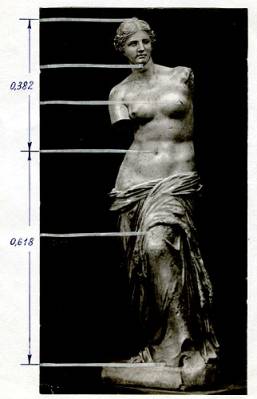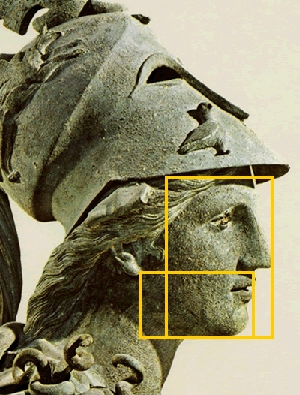Posts tagged ‘greek art’
The Golden Ratio in Greek Art and Architecture
Pythagoras (560-480 BC), the Greek geometer, was especially interested in the Golden Section, and proved that it was the basis for the proportions of the human figure. He showed that the human body is built with each part in a definite Golden Proportion to all the other parts. Pythagoras’ discoveries of the proportions of the human figure had a tremendous effect on Greek art. Every part of their major buildings, down to the smallest detail of decoration, was constructed upon this proportion.

The Parthenon was perhaps the best example of a mathematical approach to art.
The Parthenon had been designed by Ictinus and Callicrates according to mathematical principles Its surrounding pillars were an example of “number” applied: 8 pillars in front, an even number, as Pythagoras had advised, so no central posts would block the view; but 17 pillars on each side.
And some of its lines were deliberately curved and slanted to correct optical distortions. But above all, the Parthenon was a crowning example of proportion in architecture. Scholars still marvel at the logical and harmonious ratios in the whole building and its various parts. And this beauty was achieved with one of the “dynamic rectangles” then in vogue. Like many Greek temples of time, the Parthenon used the “root five rectangle,” a rectangle with an irrational side the square root of 5.

The Venus de Milo sculpture was carved by the Greek sculptor Alexandros. The statue adheres, intentionally or not, strictly to the Phi, Golden Ratio or Golden Proportion of 1.6180339887.

In this Statue of Athena, the first Golden Ratio is the length from the front head to the ear opening compared with the length from the forehead to the chin. The second one appears in the ratio of the length from the nostril to the earlobe compare with the length from the nostril to the chin.
Phidias was an Athenian sculptor, the son of Charmides, and is generally acknowledged as the greatest ancient Greek sculptor and instigator of the classical style of the 5th and 4th centuries BC. Although few facts are known about his life, it is believed he lived from around 490 until 430 BC. No originals of his work exist, but his recognition as a renowned sculptor has been guaranteed due to the praise of ancient writers, as well as the influence his sculptures had on the development of the art. He gained most of his fame for his two enormous chryselephantine (gold and ivory) sculptures: One of Athena in the Parthenon, and the other of Zeus at Olympia. These statues had such a profound impact that they determined all subsequent conceptions of Athena and Zeus.
http://library.thinkquest.org/trio/TTQ05063/phibeauty3.htm
http://milan.milanovic.org/math/english/golden/golden4.html